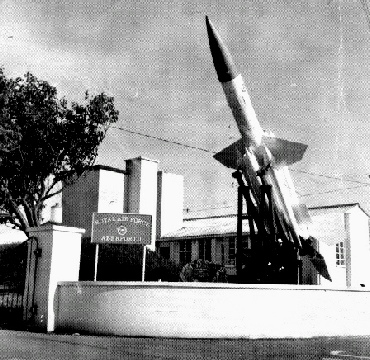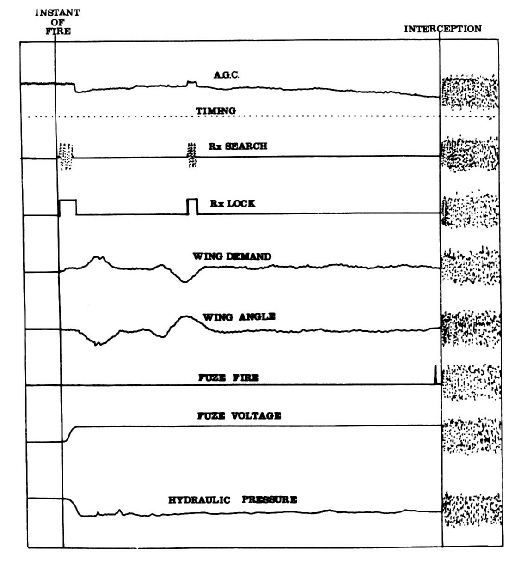


1940 -

Recording the History -





Yes! RAF Aberporth really does exist and the photograph of the main gate above proves it.
To enlighten those who have not yet sampled the delights of Aberporth it is situated on the coast of Cardiganshire, West Wales, near the southern end of Cardigan Bay map above.
The reason for our existence here is the adjacent Royal Aircraft Establishment (RAE) Aberporth Guided Missile Range.
RAF Aberporth is purely a domestic and administrative site, as the 'engineering' takes place within the RAE Aberporth area 2 miles away.
Although the Station is situated on an airfield, it is not an RAF airfield; it belongs to the RAE, which causes some confusion. All three Services are involved in trials at the RAE and are accommodated on the Station which causes even more confusion. Those who doubt the feasibility of a unified Service would be surprised how easily the three Services can live together, albeit in a cabin/bunk/room.
Before explaining exactly what the RAF Aberporth engineers do, it would be as well to outline the facilities available and the basic Range organisation.
The RAE Aberporth Range Facilities
The RAE Aberporth Range is part of MOD (PE) and is wholly civilian manned. It offers facilities for the realistic trials of modern guided weapons systems and related equipment. The facilities are available to civilian contractors during the weapon systems R & D phase, to the three Services for practice trials and lately to certain foreign nations. The RAF is the Range's biggest customer.
The Range area is some 80 Km x 80 Km of Cardigan Bay and covers many types of guided missile firings from the shore, aircraft or ships against floating marine targets or unmanned target aircraft flying over the sea. Whilst the Range is primarily intended for weapon trials, the combination of unique instrumentation facilities and an established trials organisation attracts non—firing trials as well. These have included such diverse activities as Concorde and Jaguar instrument calibration flights, navigation development trials, echoing area measurements and satellite tracking.
Possibly the most unusual trials were those involving the radar tracking of wild birds. One series of trials involved the use of a special spectrum analyser to establish the wing beat frequencies of different birds: the birds were identified via bore—sight TV cameras which are mounted on the radar dishes.
In another trial wild mallard ducks were released and tracked to try and establish if they had preferred direction of flight immediately after take—off.1
Surveillance
Range air/sea space is under constant radar and optical surveillance. The primary air surveillance radar is a Marconi Type S300 with a range of some 200 miles. Sea surveillance is achieved by three 'ship radars' situated around the bay, and, optically, from the various camera observation posts. Shipping is a big problem. What goes up must come down and the fall out area is frequently fouled by trawlers whose skippers are notoriously stubborn and can only occasionally be persuaded to move. The Royal Navy has more success — a bottle of duty free scotch works wonders. The range being in the middle of a holiday area with attractive beaches the summer brings myriads of small boats which add to the problem. The possibility of seeing a missile firing is a major tourist attraction in the area.
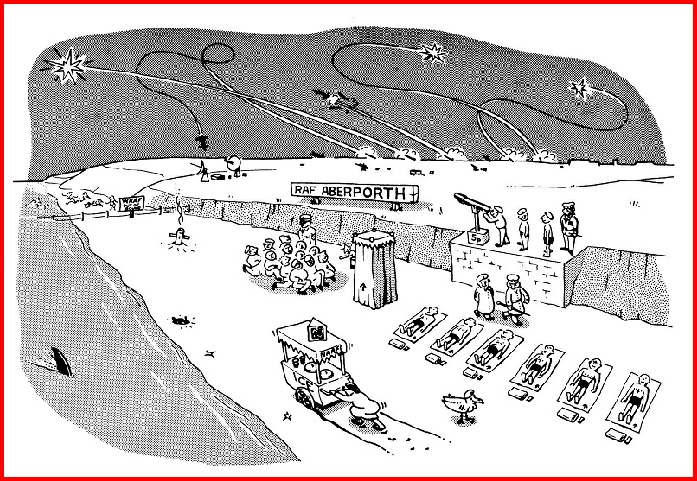
A MAJOR TOURIST ATTRACTION I ! !
The control of ships, aircraft and targets involved in trials is exercised by tracking radars which provide real—time situation displays on large automatic plotting tables. Four tracking radars are available; two IC' Band AN/FPS 16 radars designed especially for the precision tracking of guided missiles, and which can be used in skin or beacon tracking modes, and have a ranging accuracy of ± 10 ft; and two radars which are an tSt Band SCR 584, which will be familiar to some of our older Radar Fitters, and an X, Band Type 83 (Yellow River) which was the Target Illuminating Radar for Bloodhound Mk 1. The latter two, and there is a standby equipment for each, have been extensively modified to incorporate analogue polar/cartesian conversion systems for plotting table display purposes. The AN/FPS 16 and Type 83 output digital data can be recorded at up to 20 points per second on magnetic tape with 17 bits for, angle and 20 bits for range. The tracking radar outputs are fed to the plotting tables via a Radar Data Computer which corrects for radar displacement, parallax etc. Offsets can be applied and varying scaling factors can be pre—programmed to occur during the trial. Height output data is computed and corrected for earth curvature. A very useful display is a difference plot which shows in real—time the difference, in two dimensions, between a target and an approaching missile.
Photography
Trajectories are recorded either photographically, using special theodolite cameras (Kinetheodolites), or by tracking radars, or both. All kinetheodolite data is recorded on 35 mm film and a number of these instruments are deployed round the Range area, each operating synchronously at up to 10 frames per second.
High speed cine cameras each with a long focal length lense provide attitude and other behaviour information. These cameras can run at up to 200 frames per second. Ultra high speed cameras operating at up to 1,500 frames per second are also avail—able and are very useful when investigating missile launch anomalies.
Telemetry
Telemetry is the science of measuring at a distance and is the most important 'tool' available for subsequent analysis. Telemetry senders are used to transmit information about the missile's behaviour to ground receivers during its flight. A typical sender will sample 45 different parameters 40 times per second and a further 23 twice per second. The parameters selected may include such items as hydraulic pressure, wing and dish angles, accelerometer outputs, and power supply voltages. The signals are received on the ground via two power driven aerials slaved to the tracking radars. All the reception and recording facilities are duplicated and the information is recorded on magnetic tapes for subsequent analysis. The information is also displayed on large screen CRT displays allowing an immediate assessment of the missiles in—flight performance to be made.
Co—ordination
A Range Controller co—ordinates all trials and allocates Range Time to the various customers. He is assisted by a Ground Controller, Air Controllers and an In—Flight Safety Officer. The Ground Controller, via an extensive communications network, is in contact with all working points on the Range. The detailed conduct of a trial involves the operation of many functions at predetermined times together with the correct routing of a large amount of digital/analogue data. To this end an automatic sequence unit and a data exchange bank are used by the Ground Controller to ensure that all the functions are correctly routed and occur in the right order, and at the correct relative times. The In—Flight Safety Officer is responsible for ensuring that the firing area is clear of shipping and monitors the missiles trajectory during the engagement. Should the missile violate a predetermined safety boundary the missile is destroyed via a fail safe destruct system.
TELEMETRY PANORAMIC RECORDS FIG.3
Post—trial evaluation is carried out using data processed by the Aberporth Data Centre to provide trajectories, velocities, altitude, miss—distance etc. The raw data is produced both automatically and manually and fed to a computer which produces permanent records in both tabular and graphical form. The telemetry tapes are replayed to produce a variety of records such as the useful low speed panoramic record in which the parameters are displayed as continuous traces, thus enabling events to be easily correlated (Fig 3). There were actually around 72 traces on a Bloodhound Mk2 Telemetry recording. Mike
Targets Subsonic
Pilotless target and manned target towing aircraft are provided by RAE Llanbedr.
Target towing Canberras of 7 Sqn RAF St Mawgan are also used for some Service firings. The RAE Llanbedr is conveniently situated 40 miles away at the north end of the bay and three basic types of target are available — Meteor, Jindivik and the supersonic Stiletto rocket.
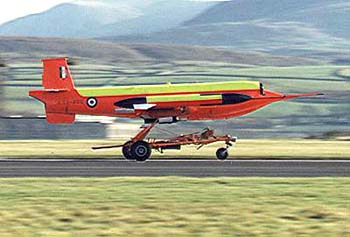
Fig 4 — Jindivik Pilotless Target lifting off from launcher trolley
Meteors can be operated as either piloted aircraft for non firing trials, pilot-
The Jindivik is extremely versatile, flying at high subsonic speeds from below 100 ft to over 60,000 ft. A wide variety of equipment can be carried to suit trials requirements. Passive radar augmentation to simulate a larger aircraft (the Jindivik has a 20 ft wing span) is by Luneberg lenses. Active radar augmentation includes travelling wave tubes and transponders.
For infra—red homing weapons the Jindivik unreels and tows behind it a bomb—like body containing a pack of infra—red flares. Possible the most important items carried are the miss distance cameras. Four small 35 mm cine cameras fitted with 1860 ultra wide angle lenses are mounted in wing pods, each pod has a camera looking vertically up and down. Thus a missile passing the target should appear on two films and provides accurate engagement geometry and miss distance data relative to the target.
Relatively few missiles are fired with live warheads as more data can be obtained by substituting instrumentation packages for the warhead. Alternatively a fixed delay can be introduced into the fuze/warhead train to ensure that warhead detonation occurs at a safe distance from the target. Inevitably some targets are lost as the result of a direct hit, but it is not uncommon for Jindiviks to make over 80 sorties before being lost or retired hurt.
Great emphasis is placed on safety and reliability in the Jindivik control and command systems, and as far as possible all air and ground systems are duplicated. Should a malfunction occur the aircraft will automatically enter a continuous orbit at a safe height until command is restored, or the aircraft destroyed by a pre—programmed spiral dive into the sea. The loss rate. of Jindiviks, other than by missiles, is as low as 0.6%.
Supersonic
The requirement for supersonic targets is met by the "Stiletto" rocket originally developed for the US Navy by the Beech Aircraft Corporation. These are air launched from a Canberra, are liquid rocket propelled and expendable. Performance is up to Mach 2 and 70,000 ft, with a potential of Mach 3 and 90,000 ft.
The Trials Planning and Analysis Organisation.
Due to the complexity of the Range instrumentation and the nature and frequency of the trials, a team of four engineering officers is permanently located at Aberporth to assist the various RAF units wishing to use the Range. The team is equally divided between air—to—air, surface—to—air and air—to—surface trials and is assisted by a small section of NCOs consisting of two SNCO Radar Fitters wiht GW experience and two JNCO Clerk Stats.
Some RAF units are regular customers, eg The Missile Practice Camp at RAF Valley for fighter air—to—air firings and the Bloodhound Firing Unit which itself is based at Aberporth.
Other units may wish to use the Range on an opportunity basis or to carry out a specific trial. The Trials Planning Analysis (TPA) organisation exists to assist the user to take full advantage of the unique facilities available, prepare the necessary documentation and instructions for the trial, conduct the trial, and, if required, analyse the results.
Trials Planning
As a complex trial can involve up to 150 people located up to 40 miles away all trials are conducted with the use of a trials specification, and the preparation of these is a major part of the TPA Flights work. Specifications set out in detail exactly what each operator or equipment has to do during the trial and lays down details of the results required after the trial. Included in the specification are the drawings and information of the flight plan of the target, predicted missile trajectory and missile destruct boundaries.
Each trial has to have a 'Sponsor' who makes on the spot decisions as the trial progresses. The Sponsor must be familiar not only with the results that he expects from the trial but with the Range facilities and organisation, and for this reason it is generally convenient for the TPA officers to sponsor RAF Trials. This is particularly useful when trials involve aircraft from external units as, due to the vagaries of the Welsh weather, equipment serviceability etc., trials can seldom be planned for a particular day.
Trials Results
After a trial, naturally, everyone wants to know how successful it was. However, unless something dramatic occurs, such as a direct hit on the target, it may take several days or weeks before all the data has been recovered and processed, and an accurate assessment made on the success or otherwise of a trial.
Current Work
The RAF trials currently undertaken or being prepared at Aberporth include Firestreak/ Red Top from Lightnings, Sparrow/Sidewinder from Phantoms, Tiger Cat (RAF Regiment), Bloodhound Mk 2 surface—to—air missile, Martel air—to—surface TV missile, SS11/AS12 air—to—surface missiles from Nimrods and live 1000 lb low level bombing by Vulcans.
In future editions, two further articles will explain in greater detail how typical Surface—to—Air and Air—to—Air firing trials are conducted.
In an Email from the author, a couple of years ago, apparently he, (in 1973, Flying Officer P S Bryan,) never got an opportunity to complete the “two further articles” as he was posted out and off Bloodhound.
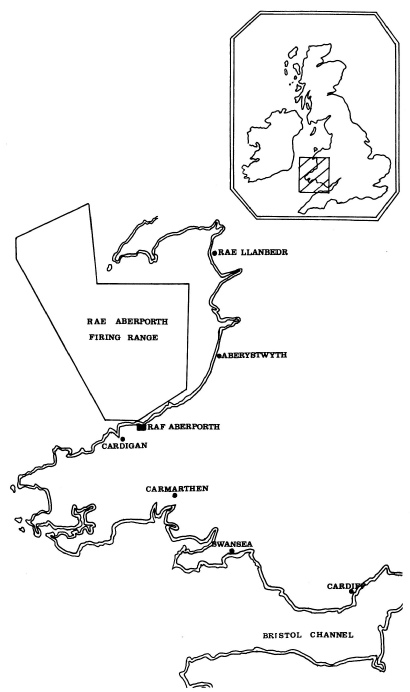
This article was written in 1973 for the Engineering Review by Flying Officer P S Bryan who was an engineering officer at Aberporth at that time. Peter Bryan contacted me a few years ago when he came across the cartoon “A Major Tourist Attraction” and told me that his follow up two articles never happened, as he was posted out.
Please remember as you read it, that it was written over 42 years ago, a decade before the Sinclair ZX81 Home Computer hit the shops.
A lot has changed at Aberporth in that time. For example, the changes in Telemetry technology, and the range area, shown below in 73’, now has inland “safety corridors” to allow Parc Aberporth to control overland testing of UAV’s like the Watchkeeper.
(From Aberporth to Senny Bridge near Brecon in fact. )
Google for more information.

Firing Trials at RAE Aberporth
